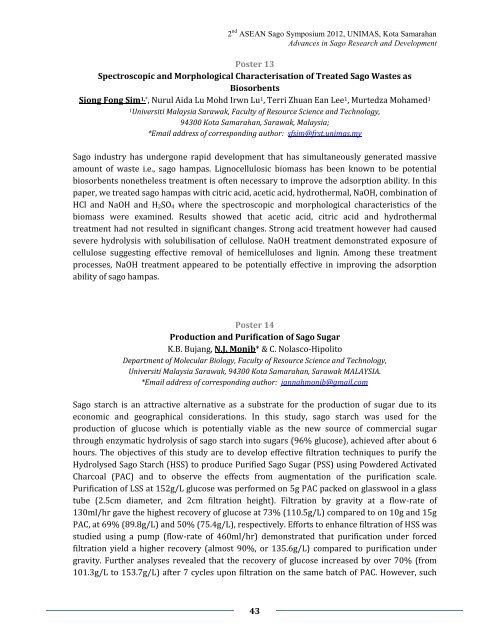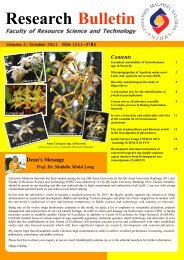2nd ASEAN Sago Symposium 2012, UNIMAS, Kota Samarahan ...
2nd ASEAN Sago Symposium 2012, UNIMAS, Kota Samarahan ...
2nd ASEAN Sago Symposium 2012, UNIMAS, Kota Samarahan ...
Create successful ePaper yourself
Turn your PDF publications into a flip-book with our unique Google optimized e-Paper software.
2 nd <strong>ASEAN</strong> <strong>Sago</strong> <strong>Symposium</strong> <strong>2012</strong>, <strong>UNIMAS</strong>, <strong>Kota</strong> <strong>Samarahan</strong><br />
Advances in <strong>Sago</strong> Research and Development<br />
Poster 13<br />
Spectroscopic and Morphological Characterisation of Treated <strong>Sago</strong> Wastes as<br />
Biosorbents<br />
Siong Fong Sim 1,*, Nurul Aida Lu Mohd Irwn Lu 1, Terri Zhuan Ean Lee 1, Murtedza Mohamed 1<br />
1 Universiti Malaysia Sarawak, Faculty of Resource Science and Technology,<br />
94300 <strong>Kota</strong> <strong>Samarahan</strong>, Sarawak, Malaysia;<br />
*Email address of corresponding author: sfsim@frst.unimas.my<br />
<strong>Sago</strong> industry has undergone rapid development that has simultaneously generated massive<br />
amount of waste i.e., sago hampas. Lignocellulosic biomass has been known to be potential<br />
biosorbents nonetheless treatment is often necessary to improve the adsorption ability. In this<br />
paper, we treated sago hampas with citric acid, acetic acid, hydrothermal, NaOH, combination of<br />
HCl and NaOH and H2SO4 where the spectroscopic and morphological characteristics of the<br />
biomass were examined. Results showed that acetic acid, citric acid and hydrothermal<br />
treatment had not resulted in significant changes. Strong acid treatment however had caused<br />
severe hydrolysis with solubilisation of cellulose. NaOH treatment demonstrated exposure of<br />
cellulose suggesting effective removal of hemicelluloses and lignin. Among these treatment<br />
processes, NaOH treatment appeared to be potentially effective in improving the adsorption<br />
ability of sago hampas.<br />
Poster 14<br />
Production and Purification of <strong>Sago</strong> Sugar<br />
K.B. Bujang, N.J. Monib* & C. Nolasco-Hipolito<br />
Department of Molecular Biology, Faculty of Resource Science and Technology,<br />
Universiti Malaysia Sarawak, 94300 <strong>Kota</strong> <strong>Samarahan</strong>, Sarawak MALAYSIA.<br />
*Email address of corresponding author: jannahmonib@gmail.com<br />
<strong>Sago</strong> starch is an attractive alternative as a substrate for the production of sugar due to its<br />
economic and geographical considerations. In this study, sago starch was used for the<br />
production of glucose which is potentially viable as the new source of commercial sugar<br />
through enzymatic hydrolysis of sago starch into sugars (96% glucose), achieved after about 6<br />
hours. The objectives of this study are to develop effective filtration techniques to purify the<br />
Hydrolysed <strong>Sago</strong> Starch (HSS) to produce Purified <strong>Sago</strong> Sugar (PSS) using Powdered Activated<br />
Charcoal (PAC) and to observe the effects from augmentation of the purification scale.<br />
Purification of LSS at 152g/L glucose was performed on 5g PAC packed on glasswool in a glass<br />
tube (2.5cm diameter, and 2cm filtration height). Filtration by gravity at a flow-rate of<br />
130ml/hr gave the highest recovery of glucose at 73% (110.5g/L) compared to on 10g and 15g<br />
PAC, at 69% (89.8g/L) and 50% (75.4g/L), respectively. Efforts to enhance filtration of HSS was<br />
studied using a pump (flow-rate of 460ml/hr) demonstrated that purification under forced<br />
filtration yield a higher recovery (almost 90%, or 135.6g/L) compared to purification under<br />
gravity. Further analyses revealed that the recovery of glucose increased by over 70% (from<br />
101.3g/L to 153.7g/L) after 7 cycles upon filtration on the same batch of PAC. However, such<br />
43



